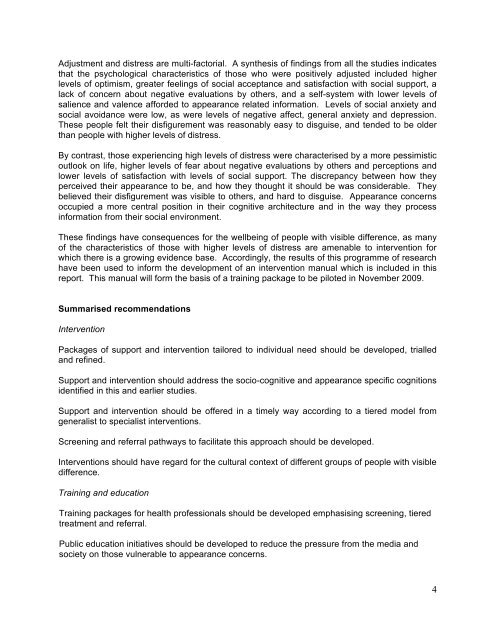Download the report - The Healing Foundation
Download the report - The Healing Foundation
Download the report - The Healing Foundation
Create successful ePaper yourself
Turn your PDF publications into a flip-book with our unique Google optimized e-Paper software.
Adjustment and distress are multi-factorial. A syn<strong>the</strong>sis of findings from all <strong>the</strong> studies indicates<br />
that <strong>the</strong> psychological characteristics of those who were positively adjusted included higher<br />
levels of optimism, greater feelings of social acceptance and satisfaction with social support, a<br />
lack of concern about negative evaluations by o<strong>the</strong>rs, and a self-system with lower levels of<br />
salience and valence afforded to appearance related information. Levels of social anxiety and<br />
social avoidance were low, as were levels of negative affect, general anxiety and depression.<br />
<strong>The</strong>se people felt <strong>the</strong>ir disfigurement was reasonably easy to disguise, and tended to be older<br />
than people with higher levels of distress.<br />
By contrast, those experiencing high levels of distress were characterised by a more pessimistic<br />
outlook on life, higher levels of fear about negative evaluations by o<strong>the</strong>rs and perceptions and<br />
lower levels of satisfaction with levels of social support. <strong>The</strong> discrepancy between how <strong>the</strong>y<br />
perceived <strong>the</strong>ir appearance to be, and how <strong>the</strong>y thought it should be was considerable. <strong>The</strong>y<br />
believed <strong>the</strong>ir disfigurement was visible to o<strong>the</strong>rs, and hard to disguise. Appearance concerns<br />
occupied a more central position in <strong>the</strong>ir cognitive architecture and in <strong>the</strong> way <strong>the</strong>y process<br />
information from <strong>the</strong>ir social environment.<br />
<strong>The</strong>se findings have consequences for <strong>the</strong> wellbeing of people with visible difference, as many<br />
of <strong>the</strong> characteristics of those with higher levels of distress are amenable to intervention for<br />
which <strong>the</strong>re is a growing evidence base. Accordingly, <strong>the</strong> results of this programme of research<br />
have been used to inform <strong>the</strong> development of an intervention manual which is included in this<br />
<strong>report</strong>. This manual will form <strong>the</strong> basis of a training package to be piloted in November 2009.<br />
Summarised recommendations<br />
Intervention<br />
Packages of support and intervention tailored to individual need should be developed, trialled<br />
and refined.<br />
Support and intervention should address <strong>the</strong> socio-cognitive and appearance specific cognitions<br />
identified in this and earlier studies.<br />
Support and intervention should be offered in a timely way according to a tiered model from<br />
generalist to specialist interventions.<br />
Screening and referral pathways to facilitate this approach should be developed.<br />
Interventions should have regard for <strong>the</strong> cultural context of different groups of people with visible<br />
difference.<br />
Training and education<br />
Training packages for health professionals should be developed emphasising screening, tiered<br />
treatment and referral.<br />
Public education initiatives should be developed to reduce <strong>the</strong> pressure from <strong>the</strong> media and<br />
society on those vulnerable to appearance concerns.<br />
4


